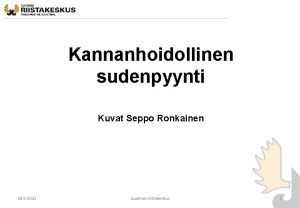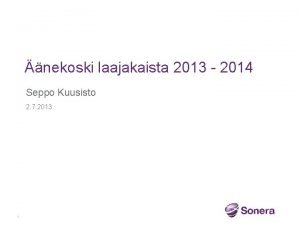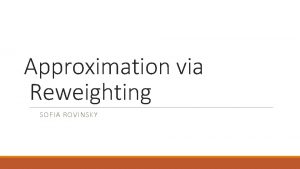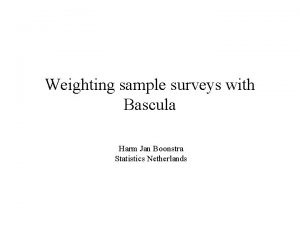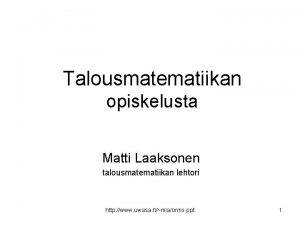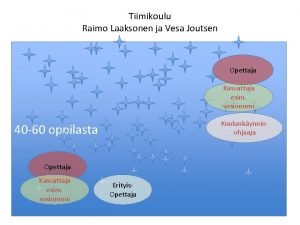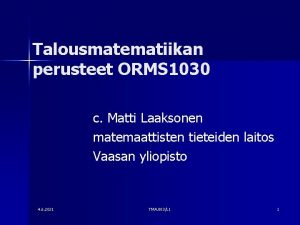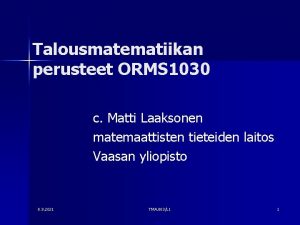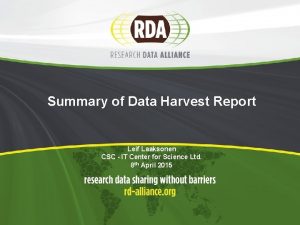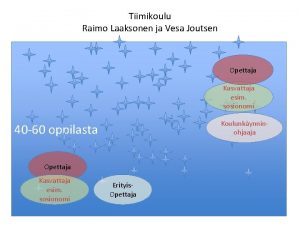Weighting and reweighting in surveys Seppo Laaksonen University



















- Slides: 19

Weighting and reweighting in surveys Seppo Laaksonen University of Helsinki Seppo. Laaksonen@Helsinki. Fi NTTS 2017 Seppo Laaksonen 1

One part is concerned the design weighting when some inclusion probabilities are missing. It is common in multistage sampling. The second main part is focused on using calibration as the ending weighting method but not as the only method if appropriate auxiliary variables are available at micro level. This should be the case in all surveys. NTTS 2017 Seppo Laaksonen 2

Content My framework for weighting Details of some weights Some references Partially artificial sampling design data file and real survey file Statistics of the 14 weights, two of them not used in estimation Happiness results Voting rates results Tobacco smoking results Conclusion NTTS 2017 Seppo Laaksonen 3

Our general framework Ordinary weights - A - A+E - A+B - A+C Possible but not recommended NTTS 2017 Seppo Laaksonen 4

A few references Deville, J-C. & Särndal, C-E. (1992). Calibration Estimators in Survey Sampling. Journal of the American Statistical Association. 376 -382. Sautory, O. (2003). CALMAR 2: A NEW VERSION OF THE CALMAR CALIBRATION ADJUSTMENT PROGRAM. Proceedings of Statistics Canada’s Symposium: Challenges in Survey Taking for the Next Decade Laaksonen, S. (2015). Sampling design data file. Survey Statistician (International Association of Survey Statisticians) 72, 61 -66. Laaksonen, S. & Heiskanen, M. (2014). Comparison of Three Modes for a Crime Victimization Survey, Journal of Survey Statistics and Methodology 2 (4): 459 -483 Valliant, R. , Dever, J. A. & Kreuter, F. (2013). Practical Tools for Designing and Weighting Survey Samples. Statistics for Social and Behavioral Sciences. Springer NTTS 2017 Seppo Laaksonen 5

Sampling design data file, part 1 NTTS 2017 Seppo Laaksonen 6

Sampling design data file, part 2 Stratified Two domain Sampling design SRS CLUSTER (Three-Stage) NTTS 2017 Seppo Laaksonen Three Four Five 7

This is more complex since third-stage inclusion probabilities are missing from the non-respondents. NTTS 2017 Seppo Laaksonen 8

Not same NTTS 2017 Seppo Laaksonen 9

NTTS 2017 Seppo Laaksonen 10

The estimated response propensities have a major role in the response propensity weights. This gives some examples NTTS 2017 Seppo Laaksonen 11

The most common calibration uses linear distance function but the French INSEE SAS Macro CALMAR 2 includes four other distance functions but one of these is a modification of the linear version. It is better to say that there are three other distance functions: - Raking-Ratio - Logistic and - Sinus Hyperbolicus Its is possible that all iterations do not work or the weights can be negative or below one that should not be acceptable. In such cases, it is best to go back toward the whole weighting, not technically move the incorrect weights subjectively to a correct area although some are using this bad ‘method. ’ NTTS 2017 Seppo Laaksonen 12

Approach of this study, the second and main part - To test three different starting weights in calibration that is recommended to be the ending methods in weighting if the enough accurate calibration margins (benchmark population values) are available. - We have tested three starting weights in calibration: (i) Basic weights (ii) Post-stratified weights (iii) Response propensity weights NTTS 2017 Seppo Laaksonen 13

14 Different weights Two weights rejected in estimation NTTS 2017 Seppo Laaksonen 14

D e c l i n g 12 Different weights in estimating happiness average Least biased in the last rows NTTS 2017 Seppo Laaksonen 15

D e c l i n g 12 Different weights in estimating voting rate Least biased in the last rows NTTS 2017 Seppo Laaksonen 16

Least biased in the last rows I n c r e a s i n g 12 Different weights in estimating number of daily cigarettes NTTS 2017 Seppo Laaksonen 17

If both micro and macro auxiliary variables are many and high quality, I recommend the chain A-E-F-D. Be careful with the distance function in calibration! NTTS 2017 Seppo Laaksonen 18

Thank you for your attention NTTS 2017 Seppo Laaksonen 19
 Reweighting
Reweighting Miika pilli
Miika pilli Palo alto
Palo alto Markus laaksonen
Markus laaksonen Mika laaksonen
Mika laaksonen Adecco hyvinkää
Adecco hyvinkää Seppo mylläri
Seppo mylläri Seppo ronkainen susi
Seppo ronkainen susi Seppo suominen
Seppo suominen Seppo suominen
Seppo suominen Anueveliiina
Anueveliiina Seppo kuusisto
Seppo kuusisto Parikkalan vaakuna
Parikkalan vaakuna Haaga-helia malmi
Haaga-helia malmi Etäympäristö
Etäympäristö Bees lca
Bees lca Instance weighting for domain adaptation in nlp
Instance weighting for domain adaptation in nlp Hkdse english weighting
Hkdse english weighting The weighting game download
The weighting game download Tf-idf calculation example
Tf-idf calculation example







